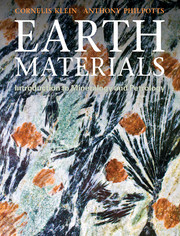Book contents
- Frontmatter
- Contents
- Preface
- Acknowledgments
- Chapter 1 Introduction
- Chapter 2 Materials of the solid Earth
- Chapter 3 How are minerals identified?
- Chapter 4 Fundamentals of crystal structures
- Chapter 5 Introduction to crystallography
- Chapter 6 Minerals and rocks observed under the polarizing optical microscope
- Chapter 7 Igneous rock-forming minerals
- Chapter 8 How do igneous rocks form?
- Chapter 9 Igneous rocks
- Chapter 10 Sedimentary rock-forming minerals and materials
- Chapter 11 Formation, transport, and lithification of sediment
- Chapter 12 Sedimentary rock classification, occurrence, and plate tectonic significance
- Chapter 13 Metamorphic rock-forming minerals
- Chapter 14 Metamorphic rocks
- Chapter 15 Some economic minerals, mainly from veins and pegmatites
- Chapter 16 Some selected Earth materials resources
- Chapter 17 Earth materials and human health
- Glossary
- Minerals and varieties
- Common igneous, sedimentary, and metamorphic rocks
- Index
- References
Chapter 4 - Fundamentals of crystal structures
- Frontmatter
- Contents
- Preface
- Acknowledgments
- Chapter 1 Introduction
- Chapter 2 Materials of the solid Earth
- Chapter 3 How are minerals identified?
- Chapter 4 Fundamentals of crystal structures
- Chapter 5 Introduction to crystallography
- Chapter 6 Minerals and rocks observed under the polarizing optical microscope
- Chapter 7 Igneous rock-forming minerals
- Chapter 8 How do igneous rocks form?
- Chapter 9 Igneous rocks
- Chapter 10 Sedimentary rock-forming minerals and materials
- Chapter 11 Formation, transport, and lithification of sediment
- Chapter 12 Sedimentary rock classification, occurrence, and plate tectonic significance
- Chapter 13 Metamorphic rock-forming minerals
- Chapter 14 Metamorphic rocks
- Chapter 15 Some economic minerals, mainly from veins and pegmatites
- Chapter 16 Some selected Earth materials resources
- Chapter 17 Earth materials and human health
- Glossary
- Minerals and varieties
- Common igneous, sedimentary, and metamorphic rocks
- Index
- References
Summary
Crystal structures represent the most fundamental aspects of minerals. In classifications, minerals are organized by chemical groups (see Sec. 2.2) as well as structure types (see Sec.7.4). Because there are about 1140 known silicates, this large chemical group is subdivided by structure type.
Many of the minerals treated in this text are silicates, and gaining an understanding of their various structure types is essential. This text is accompanied by CrystalViewer, which incorporates all the crystal structures of the minerals that are systematically treated in Chapters 7, 10, 13, and 15. Furthermore, each systematic mineral description is accompanied by an illustration of its structure, its mineral name, its chemical formula, and a shorthand notation known as the space group. This chapter provides you with the basic aspects of crystal structures, which will provide you with a good understanding of the crystal structures both in CrystalViewer and in the crystal structure illustrations in this text.
Naturally occurring chemical elements
In Section 2.1, we introduced the definition of mineral in which one of the clauses states with a definite, but commonly not fixed, chemical composition. That led to the concept of minerals with a fixed composition such as quartz, SiO2, and minerals with a variable composition, such as members of the olivine series, ranging from Mg2SiO4 to Fe2SiO4, with the general formula (Mg, Fe)2SiO4.
- Type
- Chapter
- Information
- Earth MaterialsIntroduction to Mineralogy and Petrology, pp. 62 - 85Publisher: Cambridge University PressPrint publication year: 2012



